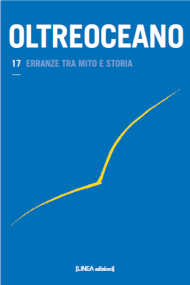Miti in discussione: il tramonto del sogno americano in Una extraña entre las piedras di Ena Lucía Portela
DOI:
https://doi.org/10.53154/Oltreoceano14Keywords:
emigrazione, emarginazione, omosessualità, mitoAbstract
Nel racconto Una extraña entre las piedras, la “novísima” scrittrice cubana Ena Lucía Portela affronta temi ricorrenti nella sua produzione letteraria, quali l’omosessualità femminile e l’emarginazione. La scelta di abbandonare l’usuale contesto di riferimento – cubano – in favore di un’ambientazione statunitense fa sì che il testo – a dispetto delle iterate dichiarazioni di disinteresse per la questione politica rese dall’autrice – diventi il punto di partenza di una riflessione sulla condizione dell’immigrato e sulla frustrazione delle aspettative di una vita migliore riposte nella società yankee.
Questioning myths: the decline of the American dream in Una extraña entre las piedras by Ena Lucía Portela
In the short story Una extraña entre las piedras, the “novísima” Cuban writer Ena Lucía Portela deals with themes that are frequent in her literary production, such as female homosexuality and marginalization. The choice to abandon the usual context of reference – Cuba – in favour of a US setting means that the text – in spite of the iterated declarations of disinterest in the political question made by the author – becomes the starting point of a meditation on the condition of
the immigrant and on the frustration of the expectations for a better life in the Yankee society.
Downloads
References
Araujo, N. (2001): Erizar y divertir: la poética de Ena Lucía Portela. Cuban Studies, 32, pp. 55-73.
Campuzano, L. (2016): Las muchachas de La Habana no tienen temor de dios. Escritoras cubanas del siglo XVIII al XXI. Leiden: Almenara.
Grinberg, L. & Grinberg, R. (1990): Psicoanalisi dell’emigrazione e dell’esilio. Milano: Franco Angeli.
Martin, S. & y Ana, B. (2008): Sociedad civil y arte en Cuba: Cuento y artes plásticas en el cambio de siglo (1980-2000). Madrid: Verbum.
Menéndez, R. (2000): El gallo de Diógenes. Reflexiones en torno a lo testimonial en los novísimos narradores cubanos. Revista Encuentro de la cultura cubana, 18, pp. 215-222.
Portela, E. L. (1999): Una extraña entre las piedras. La Habana: Letras Cubanas.
Rubio Cuevas, I. (2001): La doble insularidad de los novísimos narradores cubanos. En C. Alemany Bay, R. Mataix Azuar & J. C. Rovira Soler (Eds.), La isla posible, III (pp. 546–556). Alicante: Asociación Española de Estudios Literarios Hispanoamericanos.
Said, E. W. (2007): Riflessioni sull’esilio. Scritture Migranti, 1, pp. 127-141.
Santos, L. (2005): Novísimas y rarísimas: melodrama y experimentalismo en la narrativa cubana escrita por mujeres. Revista de crítica literaria latinoamericana, 62, pp. 195-210.
Uxo, C. (2010): Los Novísimos cubanos: primera generación de escritores nacidos en la Revolución. Letras Hispanas: Revista de literatura y de cultura, 7, 1, pp. 186-198.
Valladares-Ruiz, P. (2012): Sexualidades disidentes en la narrativa cubana contemporánea. Woodbridge: Tamesi.
Downloads
Published
How to Cite
Issue
Section
License

This work is licensed under a Creative Commons Attribution-NonCommercial-ShareAlike 4.0 International License.
The authors undertake to comply with the following conditions, which are considered accepted at the time of submission of their contributions.
The sending of a text implies that it is unpublished and not submitted to be published elsewhere.
1. If accepted, the author shall confer on the publisher the right to publish and distribute it both in paper form and in the online electronic edition. The published articles will be downloadable and made available in open access.
2. Provided that it correctly indicates that the first publication took place in the journal Oltreoceano. Rivista sulle migrazioni the author has the right to: a) reproduce the article in separate extracts or collected in a volume; b) publish the article on their personal website or teaching site provided that these sites are of a non-commercial nature; c) deposit the article in online archives of a non-commercial nature, linked to the institution they belong to or as part of projects for the non-commercial dissemination and open access of scientific works.
The use of contributions by third parties, for commercial or otherwise unauthorized purposes, is not allowed. The publisher declines all responsibility for the unauthorized use of the material published in the journal.












